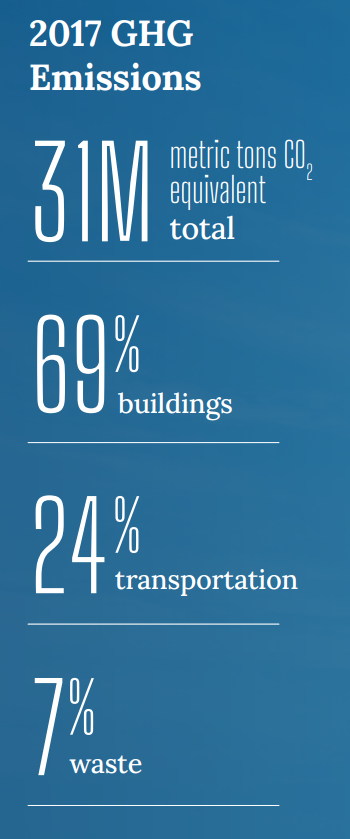Electrify Chicago
An independent tool for viewing City of Chicago building data
According to the
2022 Chicago Climate Action Plan,
69% of Chicago's emissions come from buildings, making
building emissions our biggest challenge and our biggest opportunity as a city
to tackle climate change. At Electrify Chicago, we showcase building performance using
publicly available data supplemented by community-submitted photographs and building
owners.
Start by looking at Chicago's buildings with the highest greenhouse gas intensity i.e. emissions per square foot. Large, efficient, buildings can perform much better than very inefficient small buildings on this metric.
New Article
📰 $30 Million In Missed Fines
The City Of Chicago failed to collect $30 million in potential fines from the building benchmarking ordinance, reducing transparency and accountability.
Legislative update! 🎉
As of late January 2024, legislation is being introduced to require new use more efficient forms of water and space heating, via the Clean And Affordable Buildings Ordinance (CABO), which will reduce the number of highly polluting and inefficient buildings that end up on this site.
If you're in Chicago,
write to your alderman to support the CABO!
Chicago Buildings by Greenhouse Gas Intensity
Note: Data includes large Chicago buildings with data from 2022, unless explicitly stated otherwise.
Note: This data only includes buildings whose emissions are reported
under the
Chicago Energy Benchmarking Ordinance. According to the City “As of 2016,
this list includes all commercial, institutional, and residential buildings larger than
50,000 square feet.” This dataset is also then filtered to only buildings with
reported emissions > 1,000 metric tons CO2 equivalent.
The latest year of data is from 2022, but we update the site regularly when new data is available, and some buildings may have failed to report that year, and only have older data available.
| Property Name / address | Primary Property Type |
Greenhouse Gas Intensity (kg CO2 eq./sqft) |
Total Greenhouse Emissions (metric tons CO2 eq.) |
|---|---|---|---|
|
Uplift Community HS -CPS
🕰️
(CPS)
900 W Wilson Ave
| K-12 School | 8.2 kg/sqft | 1,227 tons |
|
Schneider -CPS
(CPS)
2957 N Hoyne Ave
| K-12 School | 8.2 kg/sqft
Highest 24%
| 427 tons
Lowest 19%
|
|
Lincoln Park Tower Condominium Association
1960 N Lincoln Park West
| Multifamily Housing | 8.2 kg/sqft
Highest 24%
| 2,714 tons
Highest 16%
|
|
NMH 211 East Ontario
211 E Ontario St
| Office | 8.2 kg/sqft
Highest 24%
| 1,552 tons
Highest 30%
|
|
Armour Square Apartments
(CHA)
3120 3250 S Wentworth Ave
| Multifamily Housing | 8.2 kg/sqft
Highest 24%
| 2,559 tons
Highest 17%
|
|
Pulaski Park
🕰️
1419 West Blackhawk
| Other - Recreation | 8.2 kg/sqft | 496 tons |
|
840 Lake Shore Condominium Association
840 N Lake Shore Dr
| Multifamily Housing | 8.2 kg/sqft
Highest 24%
| 2,292 tons
Highest 20%
|
|
11203 S ELLIS ST
11203 S ELLIS ST
| Office | 8.2 kg/sqft
Highest 24%
| 500 tons
Lowest 26%
|
|
3838 N BROADWAY
3838 N BROADWAY
| Multifamily Housing | 8.2 kg/sqft
Highest 24%
| 580 tons
Lowest 32%
|
|
Dearborn Homes
2960 S Federal St
| Multifamily Housing | 8.2 kg/sqft
Highest 24%
| 5,825 tons
Highest 5%
|
|
180 North Jefferson Apartments
180 N Jefferson St
| Multifamily Housing | 8.2 kg/sqft
Highest 24%
| 1,878 tons
Highest 25%
|
|
Hilton Chicago
🚩
720 S Michigan Ave
| Hotel | 8.2 kg/sqft
Highest 24%
| 16,801 tons #23 Highest
|
|
1819 S Michigan Condominium Association
1819 S MICHIGAN AVE
| Multifamily Housing | 8.2 kg/sqft
Highest 24%
| 942 tons
Highest 47%
|
|
Cal-Met Village Apartments
4101 S CALUMET AVE
| Multifamily Housing | 8.2 kg/sqft
Highest 24%
| 474 tons
Lowest 23%
|
|
Juvenile Temporary Detention Center
1100 S Hamilton Ave
| Mixed Use Property | 8.2 kg/sqft
Highest 24%
| 8,346 tons
Highest 3%
|
Data Source:
Chicago Energy Benchmarking Data
